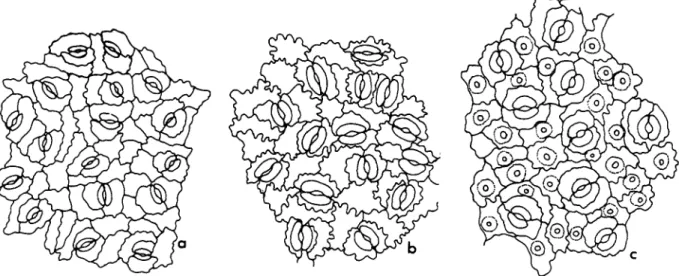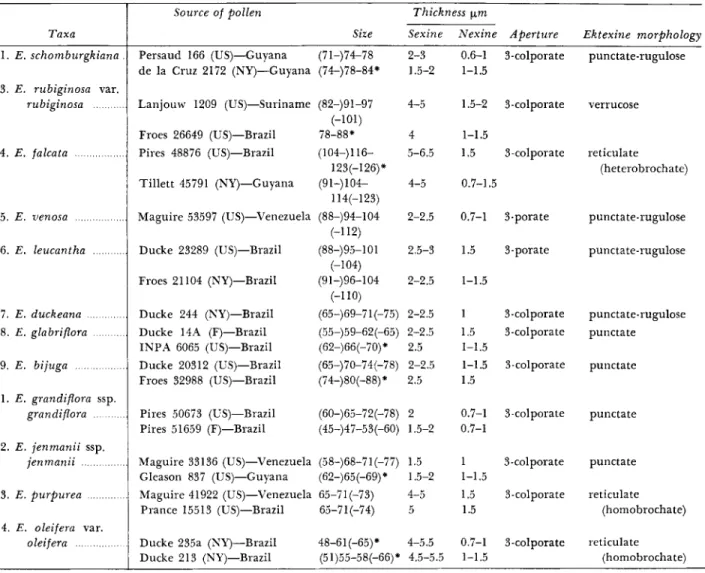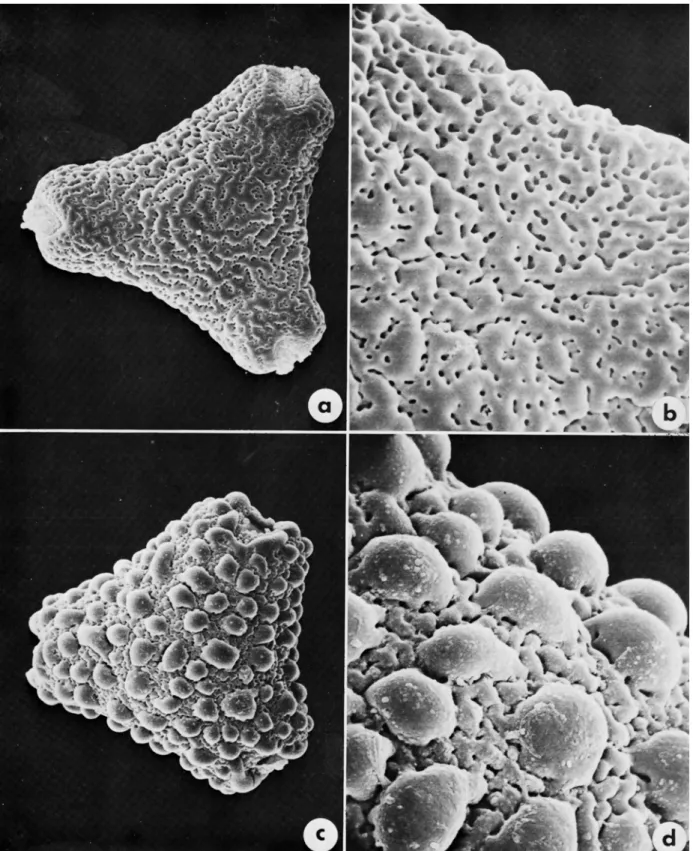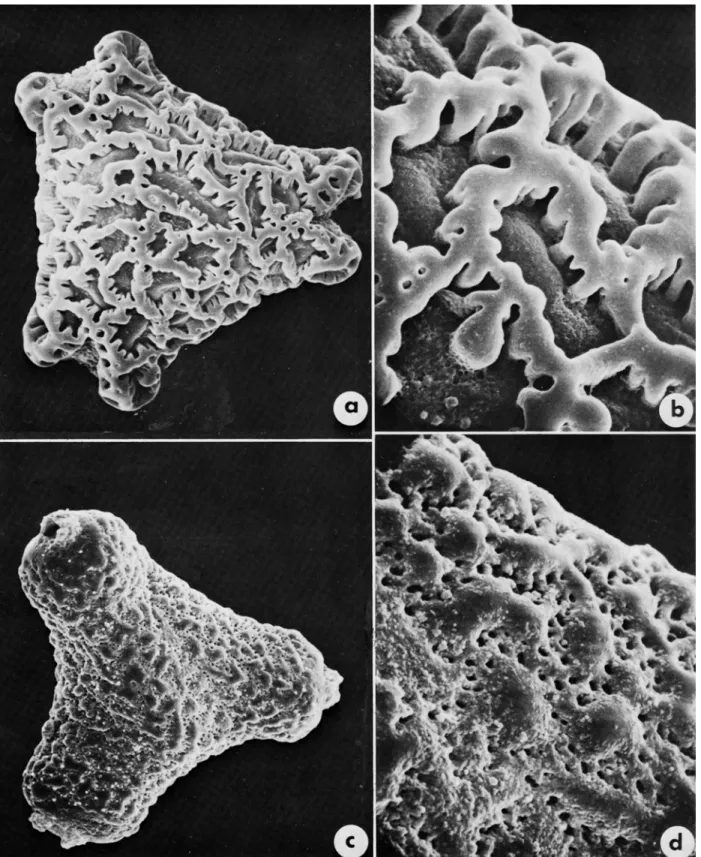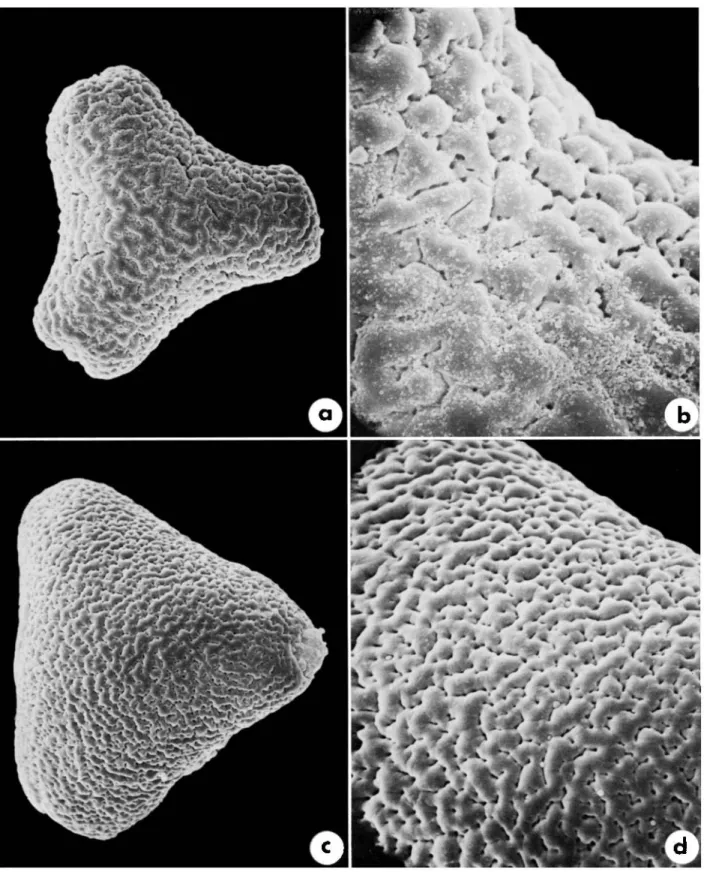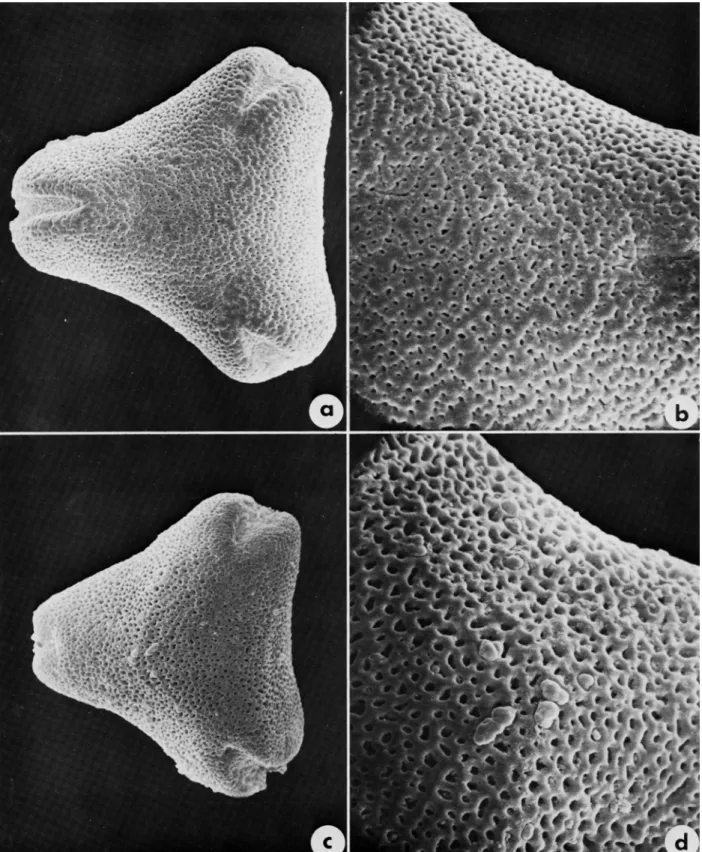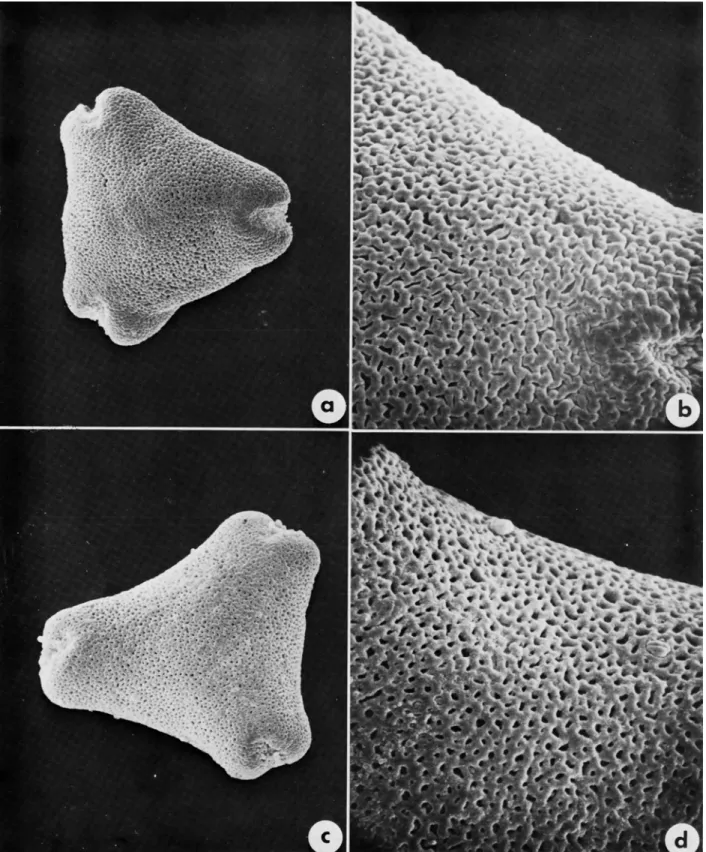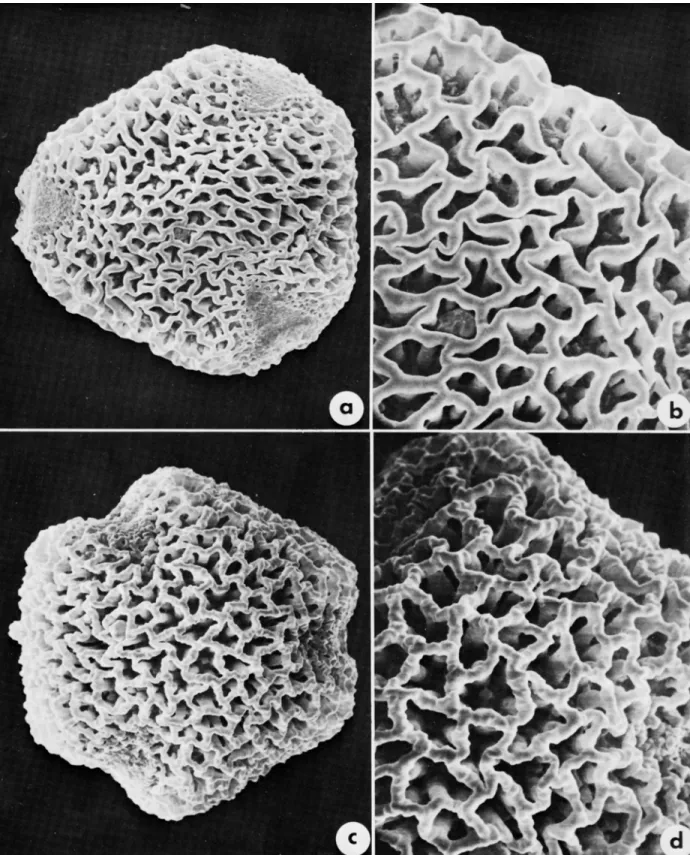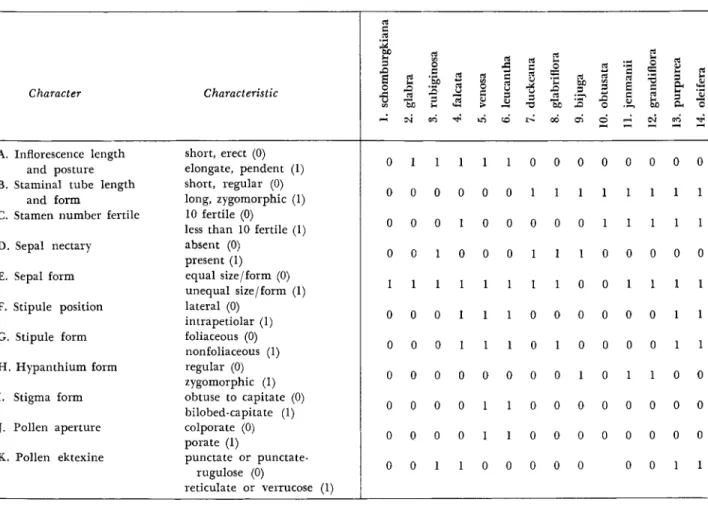At the base of the filament tube, the tips of the nectaries are usually evident. At the same time, the folded filaments reflect and assume the posture characteristic of the taxon involved. The same kind of pattern prevails in the mountainous sandstone region of the Pakaraima Mountains.
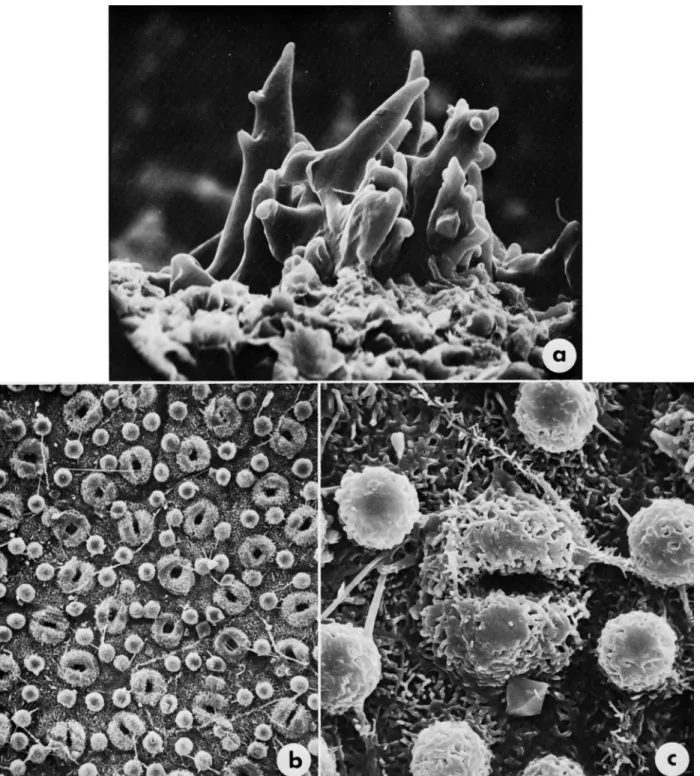
Eperua schomburgkiana Bentham
Leaflets whorled narrowly marginally; inflorescence axes glabrous; bracteoles 9-10 mm long, ovate-ovate; pedicels or sepals glabrous; northwestern Brazil. Leaflet surfaces strongly discolored, densely papillate-ceriferous on the lower surfaces (at least X 30), the "wax bodies" continuous, concealing epidermis; bracteoles conspicuously scarious marginal, persistent at least until anthesis, triangular-ovate. Petals pink, lilac, rose-purple or purple; fruit more or less square, less than twice as long as broad.
Leaves mostly 4-jugate; sepals 12-18 mm long; petal 14-25 m long, 22-35 mm wide; ovary and gynophore tomentulose densely; staminal tube somewhat zygomorphic, 3.5-9 mm long; near Manaus, Brazil. The petals are dark gray to purple with darker purple and white spots, mottled, white at the base, 5-10 cm long and 4-8.5 cm wide. Large forest tree with oval to elliptic leaves, base round-obtuse; petal pale lilac.
17 mm long, glabrous; fruits oblong-oblanceolate, 25 cm long, 8 cm wide, somewhat dry, glabrous, carpophore 2 cm long, glabrous; ripe seeds not seen. This species seems a logical candidate for the taxon from which those species with long pendulous inflorescences may have evolved.
Eperua glabra Cowan
2 mm long and 1.5 mIn wide, the bracteoles 2.5 mm long, 3 mm wide, ovate-ovate or oblong-ovate, concave, arising about one-third the length of the pedicel from its base; pedicels 20-30 mm long, 1-3 mm in diameter, finely rusty tomentulose, the hypanthium mm long, 4.5-6 mm in diameter, microtomentulose externally; sepals green, the two outer ones larger, cucullate and with one raised gland externally near the tip, microtomentulous externally, glabrous on the inner surface, narrowly oblong to oblong-elliptic to ovate, fleshy, 13-30 mm long, 4-15 mm wide; petiole clear, dark pink to red to purplish red, 13-35 mm long, 22-50 mm wide, broadly flattened to flabelli-shaped, basally truncate, the four petalodia 0.6-1.2 mm long, triangular-ovate, glabrous; stamens persistent in young fruit, most or all apparently fertile, 9 or 10 basally united in an equilateral tube 1.5-3 mm long, glabrous except in the tube. DrSkusSie.-until new field study brings together more adequate representation of the two forms of E. T he verrucose pollen of this species appears to be between the punctate-rugulose pollen of the basic stock and the punctate form of more advanced taxa. .
Large tree 8-40 m high, trunk 20-80 cm in diameter, bark brownish-grey with rather large lenticels, branches very sparsely puberulous, usually smooth and often nitid; stipules caducous, 2.5–4.5 mm long, 1.5 mm wide, triangular-lanceolate, acuminate, joined in a bipartite, intrapetiolar stipular body, glabrous or minutely puberulous outside; petioles mm long, usually minutely puberulous, rachis mm long, usually minutely puberulous; leaflets 3- or 4-jugate, (seedlings bijugate), the petioles. mm long, canaliculate on upper side, minutely puberulous, sometimes glabrous or glabrous, leaves minutely acute punctate, plane, chartaceous to thinly coriaceous, glabrous, falcate-elliptic cm long, 3-7.5 cm wide, base usually obtuse or rounded- obtuse, rarely acute, apex acute to long-acuminate and usually mucronulate, costa and venules prominular; inflorescence a terminal, drooping raceme of racemes (6.5-)lo-I4 (-25) dm long, axis usually glabrous except minutely. 4 mm long, the filament of the one free stamen villose in the basal half, 20-30 mm long, filaments of the larger stamens 32-45 mm long, glabrous over the stamen tube, smaller ones 20-25 mm long, villose, the anthers ca. 8 mm long and 3.5 mm wide, oval-oblong, smooth; stigma capitate, style glabrous, 40-42 mm long, ovary oblong to oblong-ovate, 6-8 mm long, 3 mm wide, velutinous, gynophore 2-5 mm long, puberulous to glabrous; fruits flat, somewhat arcuate-oblong, 24-36 cm long, 6.5-9.5 cm wide, minutely strigulose but eventually smooth, seeds flat, oval, 33 mm long, 22 mm wide, margins broad, seed coat thin. , red-brown, minutely tessellated. lectotype BM) "Cayenne 1775".
The lectotype sheet has caused some confusion and could easily influence the nomenclature of the species. Large tree up to 30 m high and 60 cm in diameter, the twigs bare; stipules persistent, stiff, laterally fused into a compound, bifid, intrapetiolar body, 4-5 mm long, ca. 4-4.5 mm long and 4 mm wide, strongly concave, broadly ovoid, hairy like bracts; peduncles 8-15 mm long, gray-serious, the hypanthium 4-7 mm long, 6 mm in diameter, minutely serious on the outside, the nectaries project just above the edge of the hypanthium;
Small to large tree (8-)12-25 m high cm in diameter, the bark grey, smooth, the branch- leaves initially micropubescent, smooth; stipules deciduous, lanceolate, sometimes somewhat arcuate, united in an intrapetiolar body 3-5 mm long, 1.5-2 mm wide, glabrous except marginally ciliolate; petioles m m long, glabrous or rarely micropubescent and glabrous, the rachis mm long, glabrous or hairy like petioles; leaflets mostly 3-jugate, sometimes 2- or rarely 4-jugate, the petioles mm long, usually glabrous but sometimes micropuberulous, sulcate on the upper surface, the blades acute-acuminate cm long cm wide, glabrous to thinly coriaceous, flat, falcate -elliptic, the base mostly round-obtuse or obtuse, sometimes the upper pairs basally acute, rarely the underside of the leaflet obtuse and the upper side attenuate-acute, the apex acute to long-acuminate, the tip often obtuse and usually mucronas, glabrous or rarely micropuberulous at the base of the costa on the upper surface, the venation prominulate to subobscure; inflorescence a terminal, pendulous raceme of racemes (37-)60-90.
Eperua bijuga Martius ex Bentham
Haec est proprie arbor regularis (fortasse vel quotidiana?) campi inundati per margines fluminum et fluminum in area circa ostia Amazonis; E. Arbor alta, ramis et foliis nudis; caulibus deciduis, non conspicuis; petiolis 3—4,5 cm longis, valde canaliculatis, rhachibus 4.5—5,5 cm longis, valde canaliculatis; foliis furcatis, petiolis 4.5—5 mm longis, lamellis minute pellucide punctatis, coriaceis, planis, 8.5—11 cm longis, 4—5,5 cm latis, basi elliptico-oblongis, basi plus minus rotundatis, sed superius acute, rotundatis. apice, venis parvis, neruo marginali distincto; inflorescentiis axillaribus, racemosis, 7.5—9.5 mm longis, axi minute nervosis, bracteis et bracteis deciduis, 2 mm longis et 1—2 mm latis, ovalibus, acutis, minute nervis, bracteis prope basin pedicelli ortis, pedicellis 8.5 mm longis, minute striatis; hypanthium 2 mm longum, 3,5 mm latum, cyathiforme, extus minute striatum; sepala apice conspicue glandulosa, anguste elliptica vel elliptica, 20 mm longa, 5—8 mm lata, extus minute striata; petala complanato-obovata, a d-basi attenuata, ca.
5 mm longis et 1,5—1,8 mm latis, elongato-lanceolatis; androecium glabrum, staminibus 7 fertilibus, filamentis 11.5—26 mm longis, staminibus fertilibus longioribus, 9 inaequabili tubo laterali coalitis 6,5 mm et 10 mm longis, antheris 3,5 mm longis, 1,5 mm latis, ovalibus, calvis; . DISCUSSION.-h Genus speciei acutis foliolis acuminatis, foliolis late rotundatis E.
Eperua grandiflora (Aublet) Bentham
DISCUSSION.-This is one of the often misinterpreted species in the genus, mainly because of the specific epithet. For a species characterized by a petal among the smallest in the genus, "grandiflora" seems completely inappropriate. It is still a rather poorly known species throughout its range, especially surprising given its frequency in the border area between Brazil and French Guiana and in the coastal plain of the latter country.
The Martin collection is the only find of this species in French Guiana and probably came from an inland site that was not later collected. There is slightly more puberulence on the hypanthium/sepals, but within the range of variation within the species. The two subspecies can be separated, in addition to geography, by the presence or absence of puberulence on the inflorescence and the size of the bracts;
The name of the latter commemorates the name of one of the most astute taxonomists of legumes in botanical history. His review of the Eperua species found in Guyana provides the basis for the current study.
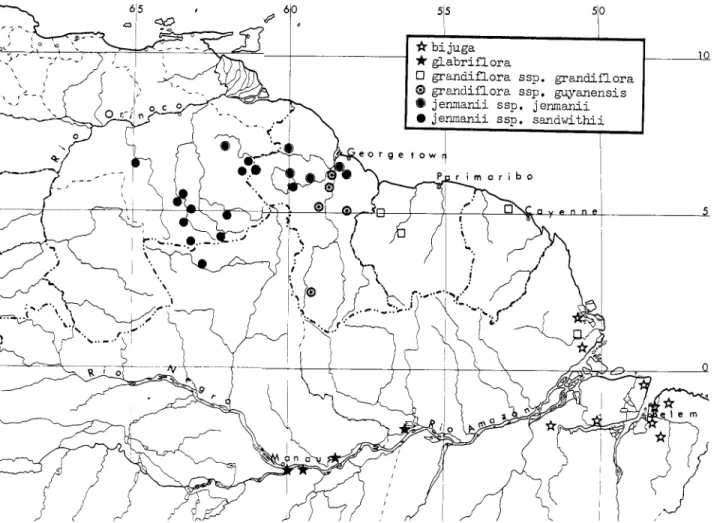
DISTRIBUTION. Frequent to dominant in savanna thickets, “moist places of the highland rainforest” (Ducke, 1940) in the Rio Negro basin of. This tree, called Jbbaru by the Indians, is the tallest tree in the Caa-tingas and their greatest ornament during the summer months. It is very common in the Rio Negro and the Uaupes, and when boating on these rivers it is the red crown.
These instruments, called Juruparis, or devils, are used throughout the United Arab Emirates (and formerly appear to have been seen throughout the Rio Negro) in the Doboxuris, or feasts, of the Indians. DrscussroN.-Everyone who has seen this species in the field and reported the experience has commented on the beauty of the tree in bloom (see Spruce's description). The inflorescence is quite distinctive, partly because of the persistent bracts and bracts, but the best feature to distinguish the species from all other congeners is the ceriferous underside of the leaflets.
Although the shape and dimensions of the leaflets vary considerably, the waxy subsurface is always striking, and the characters of the inflorescence are constant, especially the bracts and bracteoles with scarious margins. The pollen grains of both species are very similar and unique in the genus due to their reticulate (homobrocate) ectexine and wide colpi.
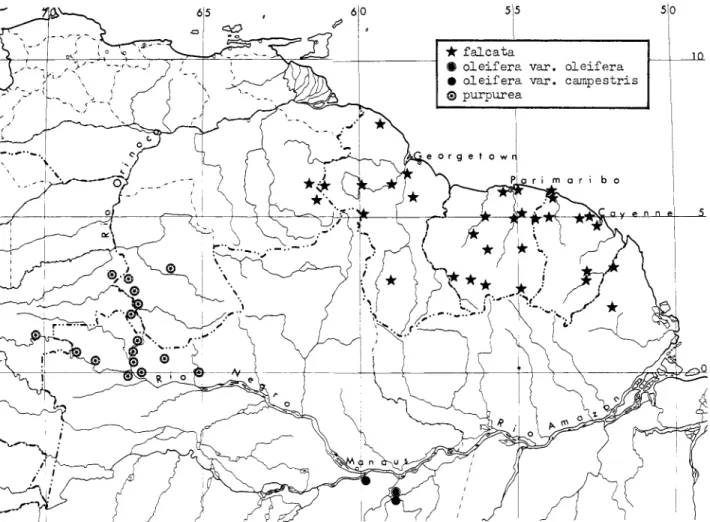
Eperua oleifera Ducke
The juice is very thick and the Indians use it as bird lime to get toucans and parrots. Microscopic wax-secreting glands produce wax filaments that cover all the lower surfaces except for a thickened marginal vein (cf. Figures 1, 3). A small savanna tree with broadly ovate, cordate leaflets, stiffer-coriaceous than the typical variety; petal pinkish-purple or violet.
Apparently the data on the labels became confused during the distribution of the duplicates, because 73-11 is clearly the campestris variety and 73 is the typical variety. The Schultes & Lopez collection differs mainly in that the various flower parts are minutely tomentulose, rather than strigulose, as is the material from the type locality. DIscussIoh'.-The first publication of the species is incomplete and in French, but as it predates the required Latin diagnosis, it is valid; the.
Between the two publication dates he discovered a new subspecific taxon, variety campestris, which he briefly described in the. T he author was much impressed by the difference in stature of the two forms, but, at least in the herbarium, the differences observed are of no more than varietal importance.
Excluded Names
Lists
